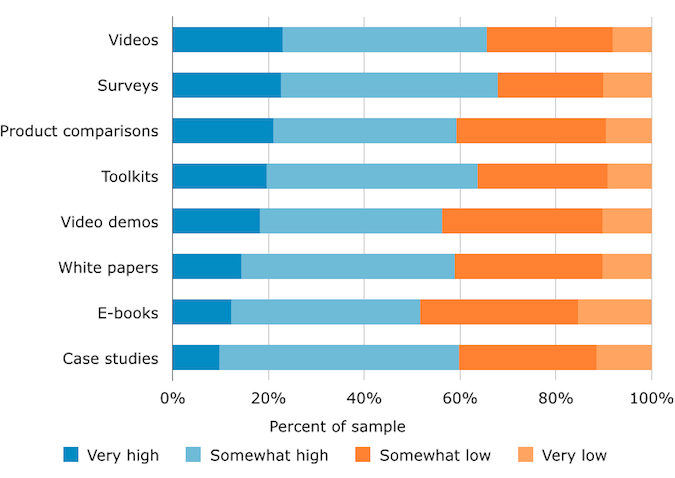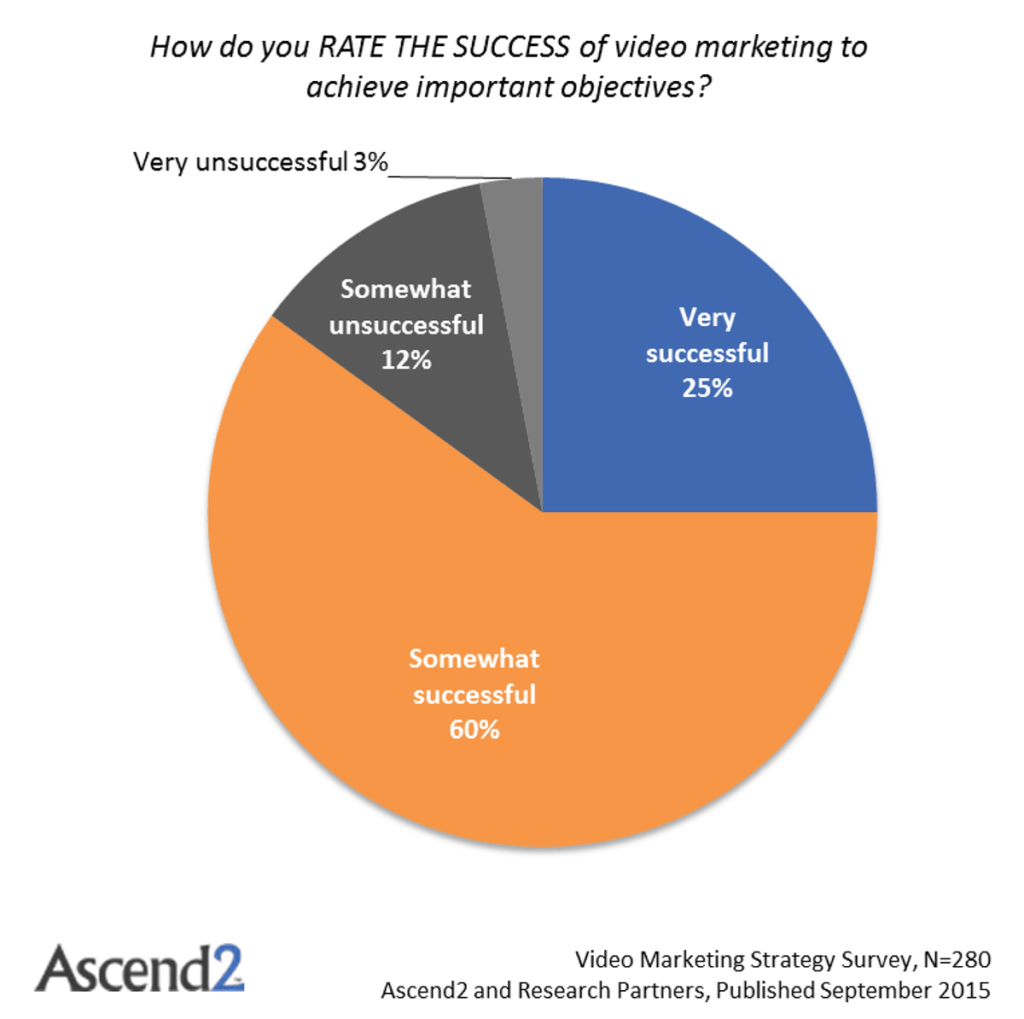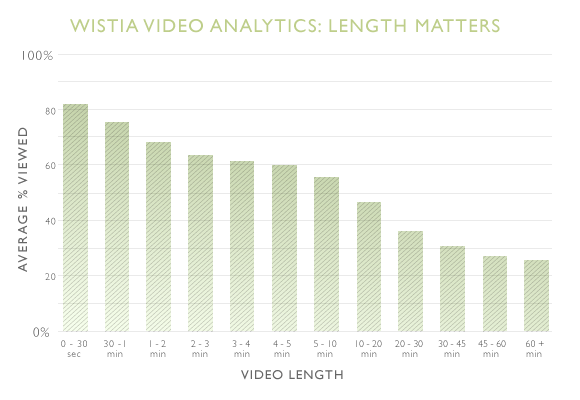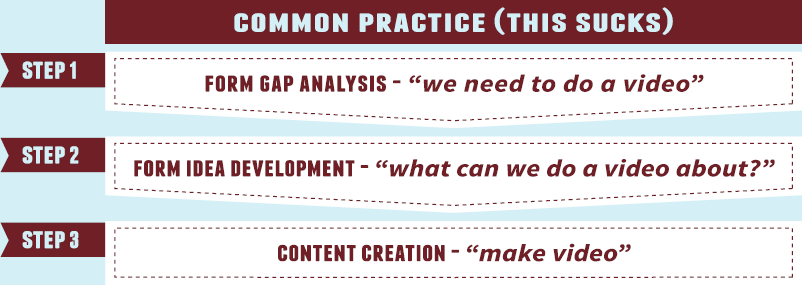How’s your video marketing?
If you just thought, “What video marketing?” or “Huh?”, it’s way past time to add this content format to your publishing mix. The web has become more and more video friendly. There’s every sign it’s only going to get friendlier.
If you haven’t started with video marketing, I’ve got six compelling reasons why you should start. And if you have started, keep reading – I’ve got nine data-based video marketing tips for strategy, creation and optimization. Whatever you’re doing – or not doing – with video, this article should give you a few ideas to move forward with.
Drumroll, please…. The six most compelling reasons to add video to your B2B content marketing:
1) The Internet will be taken over by video… if it hasn’t already happened.
According to Cisco’s Visual Networking Index (VNI) study, “Nearly three-fourths of the world’s mobile data traffic will be video by 2019.“
2) Videos are great for lead generation.
That’s what Software Advice learned when they surveyed B2B marketers for their 2014 B2B Demand Generation Benchmark IndustryView study. But note how they broke out “video demos”. Those didn’t do so hot.
3) YouTube is still the second largest search engine.
‘Nough said.
4) Most of your competition is already doing video marketing.
76% of B2B marketers are already using videos, according to the Content Marketing Institute and Marketing Profs 2015 B2B Content Marketing Trends report.
5) And most of your competitors think video is effective.
Videos came in nose to nose with blogs for effectiveness in that same Content Marketing Institute study.
They’re not the only ones saying it. Ascend2 reports even higher effectiveness ratings. 25% of the marketers they surveyed said their video marketing was very successful. 60% said it was somewhat successful.
6) Videos increase engagement.
Distilled.net took a close look at engagement rates for blog posts with and without videos. The posts with videos got significantly more shares:

They also discovered posts with videos get a longer average time on site. Posts with videos got an average time on site of 5 minutes 29 seconds. Post without videos got only 4 minutes 46 seconds.
Wanna do more with videos on Facebook? Quintly recommends it. They did a study recently that found Facebook posts with videos get significantly more engagement than any other format. Even more interesting – they found that a mere 3.2% of Facebook posts are videos. Major opportunity!
“I get it! So I need to add more video to my B2B content marketing. HOW?”
Great question. Here’s how:
1) Make it mobile.
About 44% of video plays will be on mobile devices by the end of this year. That’s according to Ooyala’s Global Video Index report for Q2 2015. That figure is expected to rise to 53% sometime during 2016.
If you’re an email marketer, that statistic should sound somewhat familiar. About half of email messages are now opened on mobile devices (more or less, depending on which report you cite).
It’s time to put a post-it note next to your computer screen that says “What about mobile?”
2) Mix it with email marketing.
There are reports of emails with videos getting up to 96% higher engagement than emails without videos. While that’s an enticing stat, it hides a problem: If you embed the video in the email, not everybody will be able to see it due to email client restraints. HTML5 does support video, but most mainstream marketers still avoid using embedded videos in their emails.
Instead, they cheat. You can, too.
First, make an image of the first frame of the video. Then add a fake video play button in the middle of the image. That triangle inside the circle button (or even just the triangle) has become the universal symbol for “Hey – it’s a video!”. Finally, link the image to a page on your site where the video automatically plays when someone lands on it. Voila:
- You have an email everybody can see in whatever archaic email reader they want to use
- You have an email that’s got a small enough file size to avoid any deliverability issues
- Almost no one will even realize you “cheated” and didn’t actually embed a video (and those who notice won’t care)
- You’ll still enjoy a nice lift in engagement rates
- Secret tip: Try appending “[Video]” to the end of the email’s subject line. Just that extra word in brackets can lift open rates by 15%

3) Mix it with blog posts.
Many people would rather watch a video than read an article. Not everyone, but many. So give them the choice.
Jon Loomer is a first-rate Facebook advertising consultant who maximized this approach to the hilt. His more recent posts skip this strategy; the video and blog combos he makes are now paid content, available only to his coaching members.
But here’s one of the earlier examples:
Note how the video is at the top of page, and note how he incorporates the blog post in the video, and the video into the blog post.
What would your execution of this strategy look like?
4) Get serious about optimizing your videos for YouTube’s version of SEO.
As mentioned above, YouTube is the world’s second largest search engine. And while it’s owned by Google, it does not use the same search algorithm Google.com uses. Getting ranked on YouTube requires different signals and best practices than getting ranked on Google.com. It’s actually easier to get ranked on YouTube (phew!) but you need to know what you’re doing.
There’s a fantastic resource to get you up to speed. It’s an SEMRush webinar called The Art of Ranking on YouTube with Brian Dean of Backlinko and Tim Schmoyer of VideoCreators.com. Give that a listen all the way through, then give it another listen to capture all the notes and action items you’re going to want to take down.
Also check out our own post, “SEO for Alternative Content Types, Part 2: Optimizing Video for SEO”, where Thorin McGee, Editor of Target Marketing Magazine, interviews SEO icon Kevin Lee.
Just to get you started here and now, here’s a quick-start list of 10 YouTube SEO essentials:
- Avoid Cryptic Video Titles. Don’t write video titles only for search engines. But do use one or two of the keywords a real human is likely to search for if they wanted to find your video.
- Include a transcription. Some video marketers say this is the magic bullet for getting ranked. Other sources suggest transcripts only help because most video descriptions are terrible. Still, adding a transcription can’t hurt, so why not add it?
- Mind your filenames. Yep – the filename of your video (for example: “SalesMeeting.mov”) matters. So give your video files meaningful, keyword-conscious names. It won’t make a huge difference, but it helps.
- Fill out the tags and description fields. These really do matter. As before, be keyword-conscious when you add this information, but always think people first, search engines second.
- Make it easy for people to share and embed your videos. Don’t turn the embed features off, okay? You want people to see your videos.
- Got videos? Set up a video sitemap. These are just like regular sitemaps, but for your video content. Google has a help page about video sitemaps here.
5) Keep it short.
While I love long-form blog posts (they get results, yo), long form video should be used sparingly. “Long”, by the way, is over 10 minutes for videos.
Wistia has some very interesting research about video length and audience engagement metrics.
“Audience engagement” is a term for how long people watch your video for before they bail. Audience engagement is also a strong ranking signal for YouTube. Some YouTubers pull tricks to increase view times, simply because they’ve seen how powerfully it affects rankings and views.
You could take it even further and apply what this other chart from Wistia alludes to: 30-second videos seem impossibly short, but that is the standard TV ad.
6) Don’t go crazy with production quality.
You don’t need a $10,000 video studio to make high-quality videos. A newish smartphone can deliver high enough resolution for professional quality. Add a reasonably nice background, a phone or video recorder stand (a stack of books counts) and some good light, and you’re done. You don’t need anything else.
For a more deluxe setup, get yourself a professional quality microphone (about $100) and a microphone stand ($20 or less). If you tend to be a loud or fast talker, consider getting a “pop filter” ($20 or less). It looks kinda like a black tennis racket and goes in front of the microphone. An actual tennis racket won’t work as well.
If you want to stand and talk in front of the camera without having to hold a big clunky microphone, find yourself a tiny “lavalier” microphone. It clips to your shirt and costs $30-50… unless you insist on getting the Cadillac version and want to spend $180.
The next most helpful thing is a basic lighting kit. These usually include a couple of light umbrellas and their stands. This will give you more even lighting, which does help video quality. You can get a nice set for $50 or so on Amazon.
The last thing would be video editing software. There are dozens of options, from free tools to $300 software packages. $150 is plenty enough to get one of the good ones. I like Camtasia myself.
Sum total for all that gear? $500 or less. And that buys you more toys than most of the popular YouTubers have.
7) Take it to Facebook, Instagram and Vine.
And to Pinterest, SlideShare, Twitter, Vimeo, Meerkat, Periscope and anywhere else. Once you’ve got the video content and the rudiments of optimizing it for views, why put it in just one place?
This brings up the issue of “native” videos. “Native” just means you uploaded a video directly to the platform (like Facebook, for example), rather than using a YouTube link or share feature to add the video.
Natively uploaded videos tend to do far better, especially on Facebook. Once you’ve got a system set up, natively uploading videos would be ideal work for an intern or a well-vetted Fiverr hire.
A word about YouTube vs. Facebook
The struggle between YouTube and Facebook for video marketing dominance is important and getting more so every day. But there are critical differences between how the two platforms measure views. When you look at the default stats, you’re not getting “apples to apples” metrics. To begin with, Facebook has a video auto-play feature; viewers activate a video play in their news feed just by scrolling, and Facebook counts that as a view. YouTube counts a view only if the viewer clicks “play”. To read a fuller accounting, read RealSEO’s worthy post about how to understand the analytics for both platforms.
8) Start with testimonials.
According to Ascend2’s study, those are the most effective kind of videos. Unfortunately… they’re also the most difficult to create. Sorry.
9) Don’t just add videos for the sake of adding videos.
This is a critical success factor. Not all content is ideal for the video format. Don’t just force your next content idea into a video because you want more videos. Make a video only if the content would be suited to the format.
Distilled’s Online Video Marketing Guide explains this so well I’m going to let them do it:
Conclusion
Video marketing can be extremely effective for B2B marketers – if it’s part of a carefully planned strategy, not just a “nice to have” that’s tacked on so you can check off the video box.
We covered a lot here, but still only just scratched the surface of video marketing. I hope it was helpful. As with every kind of marketing, the best way to know what works is to try a lot and track a lot. Fail fast and learn faster. Expand on what works, and toss what doesn’t – even if it’s a best practice.










